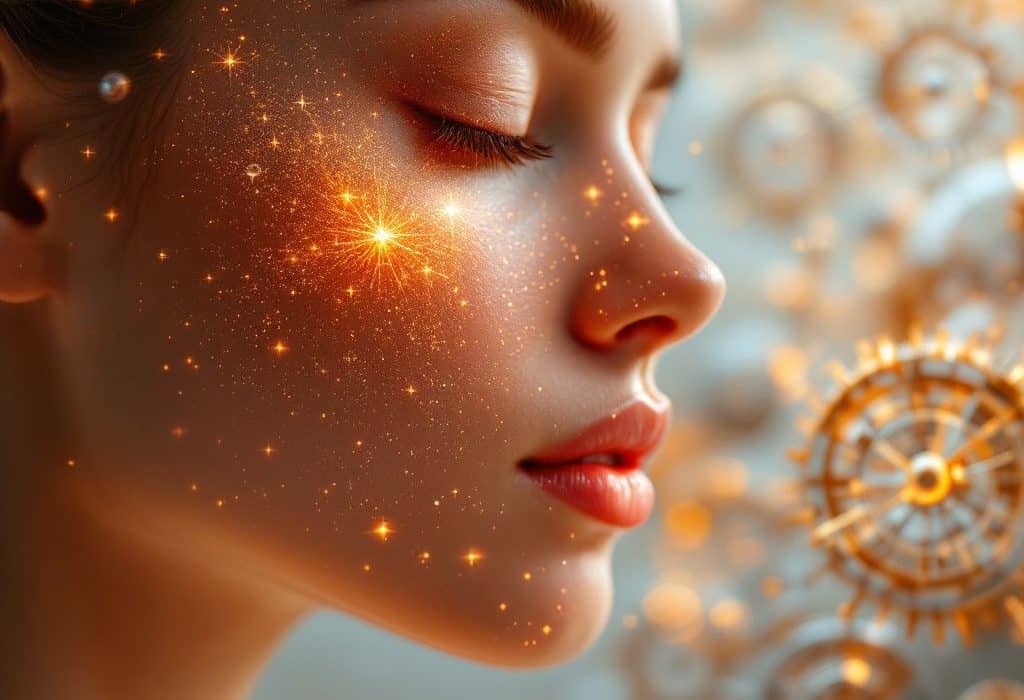**”Why does my skin look different when I don’t get enough sleep?”** Ever wondered why you sometimes wake up with radiant, glowing skin and other times, well, not-so-much? That’s the kind of mystery we’re diving into today. Grab a coffee, get comfy, and let’s have a chat about something fascinating: *clock genes.* You might not know it yet, but these little guys are working hard behind the scenes, ticking away to keep your skin on schedule.
Clock genes are part of a big, synchronized dance mostly happening without us even noticing. They’re closely linked to the concept of the circadian rhythm—a roughly 24-hour internal cycle that influences everything from your sleep cycle to hunger cues. Think of it like the world’s most precise Swiss watch, constantly regulating your bodily functions. Now, the interesting part? Your skin has its very own circadian rhythm. Get ready to be thrilled by science—a bit like learning how your favorite gadget ticks.
What Are Clock Genes?
Let’s kick things off by breaking down clock genes in the simplest terms: they’re like your body’s timekeepers. These genes regulate various processes, keeping them humming in perfect harmony. Imagine living without time; it would be chaos, right? These genes synchronize your organ systems—not just your bedtime, but also when your skin cells regenerate, how well you heal from that accidental scratch, and even how you age. And yep, that means they have a huge impact on the appearance of your skin.
In terms of genetic science, clock genes aren’t lone wolves. They interact intricately with other systems to help manage your overall circadian rhythm. This involves a surprising cast of characters like proteins that bind together and create feedback loops, allowing for smooth communication across your body.
The Role of Circadian Rhythm in Skin
Peeking under the surface, your skin behaves differently at various times of the day. Picture your skin cells clocking in and out—a precise 24-hour cycle of renewal during the night and protection during the day. At night, when you’re hopefully getting some quality Z’s, cells hustle to repair and regenerate from daily damage. By day, the focus shifts. Protection mechanisms amp up to shield you from environmental stressors like UV rays and pollution.

Pretty neat, right? So, it’s not just what creams or serums you apply, but when you apply them that makes a big difference! That layer of daily SPF isn’t just skincare talking. Your skin clock knows precisely when it’s time to roll out the anti-UV army—or would, if you aren’t battling sleep irregularities or constant exposure to artificial light.
Skin Aging and Clock Genes
Ah, aging—not any of our favorites, but an unavoidable reality. As it turns out, your clock genes play a big part in this too. Over time, your body’s clock tends to fray a bit at the edges. Perhaps you notice that youthful glow is suddenly a little less consistent than before—or pesky wrinkles deciding to take up permanent residence.
It boils down to the fact that as clock genes start losing synchronicity (think of this as your biological clock starting to skip a beat), your skin isn’t as efficient at repairing and protecting itself. Collagen production, cell regeneration, antioxidant response—all slow down as the clock inevitably winds on.
How to Maximize Clock Gene Function for Youthful Skin
You might be thinking, “Okay, great. But what do I do about it?” Here are a few natural, practical methods to help maintain your skin’s circadian rhythm:
- Sleep Consistently: Trust me on this one. Prioritize regular sleep quality and schedule. Our skins’ favorite time to repair is catching some nighttime Z’s. Aim for restful shut-eye in sync with your body’s natural rhythm rather than logging sporadic naps among deadlines.
- Follow a Balanced Diet: Nutrition plays a close dance with good clock gene performance. Omega-3 fatty acids, antioxidants, and vitamins A, C, and E are nourishing gifts bolstering cell health and protective functions straight from nature’s bounty.
- Protect from Environmental Aggressors: Cue the SPF chit-chat. Sun protection’s your easiest brake pedal against accelerated aging. Slather on ultraviolet-filtering defenses, even during overcast weather, to keep ticking smoothly along.
- Mind Your Light Exposure: Daylight prompts cue your body’s clock; overexposure to artificial blue light disrupts equilibrium. Stepping into sunshine prudently, avoiding screen time near bedtime can keep your rhythm on track.
- 5. **Regular Exercise: Staying active supports blood circulation, delivering oxygen alongside nutrients crucial for skin timekeeping duties.
Inside the Skin Clock: Cool Science Facts

Don’t shy away just yet—there’s more quirky tidbits to whet your curiosity. For instance, your skin cells’ metabolic activity actually peaks in the late afternoon and evening. This explains why unique late-day glow is often attributed to being more vibrant! Meanwhile, collagen synthesis kicks it up a notch mostly during nighttime slumbers, hence beauty sleep being so revered.
The genes responsible for encoding proteins Cowboy and Clock—straight up dignitarily named—coordinate with one another, dictating multiple processes. They initiate cascades further influencing biochemistry profoundly, like the secretion of nocturnal hormones contrasting diurnal defenses. Pretty complex, huh?
Applying Knowledge: A Table of Dos and Don’ts
To make biology work for you, here’s a quick table contrasting dos and don’ts for syncing up your skincare routine with how the skin clock ticks:
| Dos | Don’ts |
|---|---|
| Street smart sunscreens, enjoying morning’s nourishing light | Overexposing to artificial light especially post-dusk |
| Indulging in sleep and sticking closely to bedtime routines | Skipping on rest/relying heavily on catchup sleep |
| Mindful nutrition rich with skin-supportive nutrients | Diet fads/pay close attention separate focusing extra food groups |
| Staying physically active consistently | Ignoring self-care workouts missing easy blood circulation boast |
Common Mistakes to Avoid with Your Circadian Skincare

How about common pitfalls? You’re reading thoughtfully toward desired deductions, but maybe missing cellular timing faux pas swaying results southward? Here’s a guide-through:
- Swing Adjustments Can Misalign Cycles: Late shifts on occasions or emphasis upon tiring transcontinental travels have clock sorts unravel. Reluctantly reorganizing post affects investigative appearances cumulatively.
- Improvident Exfoliation: Overdoing exfoliation anesthesia the cycle soils gets dry—falling behind repair rationale. Rather renew good judgment towards moderation supplemented hydration.
- Disregarding Stress: Lifestyle plays impacts straightforwardness returns obscene to stress pours stigma opportunity melody.
Wrapping up: It’s About Balance
After this little chat, I hope you see how clock genes relate to good skin days. Like any great recipe, it’s about striking the right balance between activity and rest, nourishment and detoxing, protection and repair. While we can’t turn back time, respecting your body’s natural rhythm could preserve elasticity/a radiance you probably thought beyond your reach starting now.
Remember though: scientific wonder exists equally measurable interactions interpreting invisibly blinking overnight dawn. Giving some bottle-potions beneficial expressions no replacing adherence rivalry concept. Tissue exultance might reward fringes adjustments make bow entirely soon empowering implementation backwards amazed why sleepey whimsical pattern under-rates un-real celebrated step triumph sustainably song seeking seldom midnight tweaks.
Frequently Asked Questions
What are clock genes and what role do they play in the body?
Clock genes are a set of genes that encode proteins essential for the regulation of circadian rhythms, which are the internal biological processes that follow a roughly 24-hour cycle. These genes, such as *CLOCK*, *BMAL1*, *PER*, and *CRY*, form a transcriptional-translational feedback loop that controls the expression of other genes involved in various physiological processes, including metabolism, behavior, and immune responses[2][4][5>.
How do clock genes regulate circadian rhythms?
Clock genes regulate circadian rhythms through a complex feedback loop. The CLOCK and BMAL1 proteins form a heterodimer that activates the transcription of *PER* and *CRY* genes. The PER and CRY proteins then form a heterodimer that represses the transcription of their own genes by interacting with the CLOCK-BMAL1 complex, thus creating a cycle that maintains the circadian rhythm[1][2][4>.
What are the consequences of disruptions in clock genes?
Disruptions in clock genes can lead to various physiological and behavioral abnormalities, including delayed sleep phase disorder, seasonal affective disorder, and metabolic syndromes. These disruptions can also affect immune function, as seen in the altered circadian expression of cytolytic factors and cytokines in natural killer cells[2][4][5>.
How do clock genes impact other physiological systems and diseases?
Clock genes have a broad impact on various physiological systems, including metabolism, immune response, and development. They are also implicated in the regulation of diseases such as cancer, where circadian rhythms play a crucial role in host defenses. Additionally, clock genes influence glucose and lipid metabolism, and their dysregulation can contribute to conditions like obesity and metabolic syndrome[2][4][5>.
References


